
Another NOTE: Although the title of this report is "Lucerne Dry Lake 1963", this Ron Hartman article also describes his teams meteorite-recovery efforts in 1999. The meteorites from this locality are known as, "Lucerne Valley" (LV). At the time that this name was formally approved (1963), it was applied to all seven of the original finds because it was assumed that they were all "probably paired". By the time that Ron first authored his Lucerne Valley website (1999), there were 10 more additional finds made, which were still named "Lucerne Valley" but were assigned numbers (001 thru 017) , and the general consensus still was to consider all of these meteorites as part of a "strewn-field". It wasn't until after the abstract titled UNPAIRED METEORITES AT LUCERNE DRY LAKE was published, where it was shown that the first 16 classified LV stones represented 9 separate meteorite falls, that any concept of useful strewn-field data coming from meteorites found on dry lakes was abandoned. Now, after more than 120 meteorite finds have been made on Lucerne Dry Lake, and even more on other dry lakes, it has become abundantly clear that meteorites move about on the surface of playas through various mechanisms of transport and often accumulate on stranding surfaces. Thus, regarding "dry" lakes, this loss of original location information essentially erases any useful strewn-field data.
Lucerne Dry Lake 1963
By Ron Hartman July 21, 1963 [(?)]
NOTE: not sure what this date means, other than being the date of find for the first Lucerne Valley meteorite, because this document was published on the IMCA "old website" sometime after April 2005. ]
 |
| Lucerne Dry Lake, Mojave Desert, San Bernardino County, Southern California |
In 1963 I became interested in investigating dry lakes for meteorites. A number of meteorites had been found on other nearby dry lakes, including Rosamond and Muroc (now, Rogers). It seemed worth the effort to investigate other nearby dry lakes. Not to say that one would expect meteorites to selectively fall on a dry lake bed, but rather, that once fallen, one could more easily be noticed as these regions are relatively free of rocks. One can search a large area rather quickly. A dry lake is also a basin. Once fallen, a meteorite is not going anywhere! It will remain until it either disintegrates or is possibly buried.
The plan was to lay out a grid using grape stakes with painted tips, and search the entire region (a rather large one, at that). As luck would have it, the first specimen [Lucerne Valley] (LV 001 in the recent literature) [see image below] was located after only 2 hours , toward the end of the first day of searching on July 21, 1963. It's mass was only 15.8 grams. In fact, the black fusion crust lay buried facing downward in a small blowout of small pebbles, just about 30 feet or so west of what is known as the Old Barstow Road (Hwy. 247). The edge of the dry lake slowly merges into a hummocky grassy land, but this specimen definitely was in the SE corner of the lake itself. My attention was drawn to it by the broken section (the way it was broken!) which was facing upward. The very black fusion crust was, if fact, buried and not noticed until I picked it up! The specimen was weakly attracted to a magnet. A corner filed smoothly revealed metallic flecks.
 |
| First 15.8 g meteorite [LV 001] found in 2 hours |
The second and third meteorites, LV 002 and LV 003, (below) were found the next month, on our second trip, by Ronald Oriti, then lecturer at the Griffith Observatory whom I had invited to join in the search along with Robert Gale, Curator of mineralogy at the Los Angeles County Museum.
 |
| The next two found |
Soon thereafter, I found LV 004 (37.4 g., the largest found to date) and LV 005 (3.1 g.) [see image below] within a few yards of one another. LV 005 was in fact perched on the edge of a gully bordering the shoulder of the road, ready to tumble into fresh mud at the slightest whisper of wind. On the way home, it was discovered that the smaller was actually a small corner that had obviously only recently broken off the larger, and had washed down a slight grade toward the road. [Currently, if two fragments can be physically-paired, their two weights are combined and both are given the same "LV number".]
 |
| 3.1g and 37.4g |
Over the next five years, six other searchers found a total of seven small individuals with a total mass of only 48.1g. (Oriti, Griffith Observer, Dec. 1968) Although I had made several trips back to LDL during subsequent years, spending many tens of hours searching, nothing more was found.
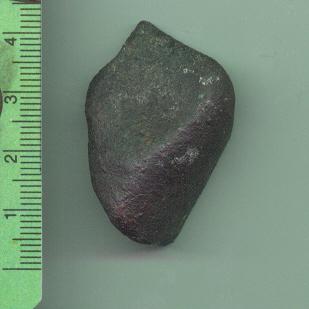 |
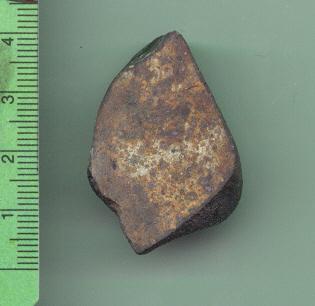 |
| more LV 004 photos |
Inspired by Bob Verish's remarkable discovery of three additional Lucerne Valley chondrites in the latter part of 1998, I ventured out once again on March 30, 1999, along with Mt. San Antonio College Planetarium staff members Jeff Schroeder and Karen Isa. It was a windy day. (Jeff had trouble holding on to the map. In fact, we found out that his top speed was 20 mph!))
 |
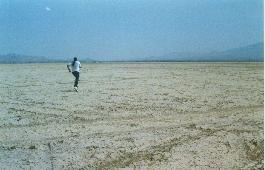 |
| Jeff Schroeder and Karen Isa (note map above Jeff in right photo) |
LV 017, only 30 mm across, 12.8 grams. It was found partially buried in a hummock slightly beyond the edge of the dry lake in the WNW sector. The picture shows clay still clinging to the fusion crust, defining the buried portion of the specimen. (Click on Bob's LV 017 link to find out the latest about this new find.) Classification is an L6 chondrite (Shock 3; weathering 4; Fa = 25.5 +/-0.6 - as per Alan Rubin, U.C.L.A.) It is not considered paired with any of the other Lucerne's. (Compare data with table in http://www.lpi.usra.edu/meteor/docs/mb83_table4.htm>The Meteoritical Bulletin No. 83.)
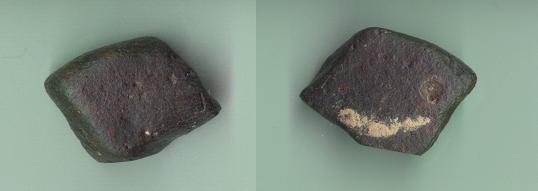 |
| 36 years later and #17 |
More to come, I'm sure. We, along with many others, continue to search the vicinity on and around LDL and have expanded that search to adjacent areas. There have been many great successes since the initial discovery, both at LDL and in the vicinity of other California and Nevada dry lakes, inspired by the LDL investigations. Results are documented periodically in The Meteoritical Bulletin. For those who are interested in finding a meteorite, the region of the Mojave Desert East and North of Lucerne Dry Lake offer excellent areas to look. Note that California meteorites found in San Bernardino County, in the Mojave desert, have usually been found not too distant from major highways and roads. There is a vast region waiting to be searched. You may search, yourself. Obtain a topographical map from the USGS, take a GPS unit so you don't get lost, define a region, (bring plenty of water with you) and look! Don't expect too much. I have spent many hundreds of hours searching. History has shown one thing: meteorite hunters who know how to recognize a meteorite usually will find one sooner or later. In the meantime, it is a way to get some fresh air and a lot of exercise. I will be happy to discuss the process of meteorite hunting with you! [Please contact:
Bob (Bolide*Chaser) Verish
P.O. Box 463084, Escondido, CA 92046-3084
bolidechaser@yahoo.com
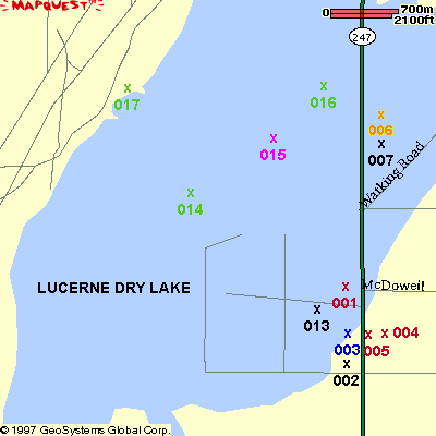 |
| map of finds by Bob Verish |
For More info See: Bolide*Chaser's version of Ron Hartman's Lucerne Valley Meteorite Web Site
click here to go to Bob Verish's Lucerne website w/articles/photos
click here to go to LV 017, the latest [Ron Hartman] LV discovery (maintained also by Bob)
Ronald N. Hartman, [(1935-2012)]
[former] Professor of Astronomy at Dept. of Earth Sciences & Astronomy,
Mt. San Antonio College, Walnut, CA 91789 (909) 594-5611 Extension 4704
Ron's [(former)] e-mail: RHARTMANxx@earthlink.net (you will need to insert 04 in place of xx and then click on a link to request spam unblocking. (The email address has been separated here to foil automated spam spiders.)
 |
Return to Field Reports[on IMCA website] |
IMCA Insights – October 2011 - Remembering Ron Hartman by Dorothy Norton & Anne Black |